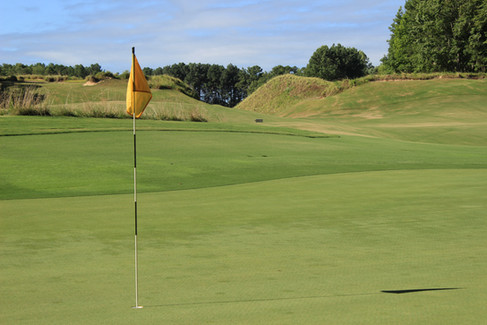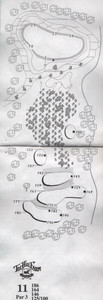STRANTZLATES: Template Holes for the Next Golden Age of Golf Course Architecture (Part I)
- Dooner
- Jan 13, 2022
- 12 min read
Updated: Jun 2, 2024
Charles Blair MacDonald - widely considered the Father of American Golf Course Architecture - created the concept of the Template Hole; a collection of the 'ideal holes' he studied and brought over from some of the finest tests on the British Isles. While these holes are not to be confused with replicas, they carry the same strategy or look from course to course, while fitting into the landscape found on each property.

Other architects - namely MacDonald's protégé Seth Raynor and his understudy Charles Banks - used these philosophies throughout their careers. Others, including A.W. Tillinghast and Donald Ross, occasionally put their own spins on MacDonald's Templates, in addition to creating a few of their own (Ross's Volcano and Tilly's Great Hazards are two best-in-class examples of this).

In other words, courses built back in the Golden Age of golf course architecture are held in such high regard for a reason. However, that high regard usually comes with some high price tags or golden gates, keeping most of the golfing world praying for an invitation or a Powerball win to secure a tee time.
While you may not consider Templates a widely-used concept in most modern courses, their principles are evident nearly everywhere - if you know what you're looking for that is...
Or... you might be asking yourself, "What the hell is a Template to begin with?" Don't worry. You're not alone. Aside from the rudimentary definition above, the guys over at The Fried Egg have created an encyclopedia of must-read Template history that will give you a better idea of the styles, strategies and examples for many of MacDonald's Template holes.
Regardless of your level of interest in templates - if you've found your way here, chances are better than good that you have an interest in the design work of Mike Strantz.
It only took us 300 words to setup the entire point of this post... if you've played multiple Mike Strantz courses, you know two truths:
No one ever created art in the dirt the way Mike did
He used (maybe a better word is 'evolved') many of the same wild design philosophies for which he is best known at each of his courses, yet all were grounded in Golden Age architecture concepts.
It's a widely known fact at this point that Strantz held Dr. Alister MacKenzie in the highest regard (who wouldn't, right?). It's also safe to conclude that many of Dr. MacKenzie's contemporaries would also carry a great sphere of influence. After all, Mike's big break came at Inverness Club, the venerable Donald Ross championship design in his hometown of Toledo, Ohio. Strantz met Tom Fazio while interning at IC prior to the 1979 US Open. The rest is, as they say, history!
Where are we going with all this? You're about to find out...

VIEWING NOTE - The rest of this article is very photo intensive. We'd recommend viewing from a desktop or tablet for the best experience. You may tap or click a photo to expand it in your browser from any device/computer.
Let's look at two examples of a classic template hole - the Redan, or in this case - the Reverse Redan.
A Redan is a template hole that features a diagonal green, moving from 4:00 to 10:00 on a clock face, fronted by a long, left front bunker that increases the difficulty as the pin moves farther back on the green. A Reverse Redan is its mirror image with the bunker on the front right. Typically, a second hazard, usually but not always a bunker, guards the rear on the opposite corner of the green. The 'kicker' is often a large false front that repels the safe shot short of the hazards.
One of the most famous examples of this is found at the Seth Raynor designed, Country Club of Charleston.

Simple. Daunting. Beautiful.
Now let's look at three Strantz takes of the hole, starting with 'yeah I can see that' to 'are you kidding me?'
First, we view the par-3 8th at Tobacco Road (Sanford, NC | Opened 1999). You'll immediately spot the similarities to Raynor's work at CC of Charleston above. It lacks the fine edges and endless sea of short Bermuda grass, but it wouldn't be Strantz if it had it.

Pretty simple to recognize right? Well now we enter the temple!
Next, take the par-3 7th at True Blue (Pawleys Island, SC | opened 1998). It's a visually stunning hole with a giant waste bunker to the right. The green climbs and follows its edging to create a myriad of playing options. Difficulty would be largely dependent on the mood of the course superintendent the morning you played. However, if you strip away all the visual intimidation and intricate bunkering, you're left with what? An albeit a very difficult, Reverse Redan.

Finally, we give you the coup de grace, the par-3 third hole at Tot Hill Farm (Asheboro, NC | opened 2000). Looking past the issues of glum weather and course conditions for a moment, you'll find a similar - perhaps more intimidating - bunker on the right, a green that winds around it's edge and all sorts of trouble deep (a creek instead of a bunker as in the photo above from True Blue).

Just as interesting is the transition from green to tee for the following hole. Both tee boxes are found back up the hill to the right, even requiring a shot over the previous green at Tot Hill Farm to reach the next fairway. Both are connected by a fringe cut, essentially adjoining the two elements together with another very old school - and very cool - design element.

When you add in the downhill tee shot, boulders and forested landscape of Tot Hill's mountainous site, you get a golf hole that fits the wildly different terrain from that of the South Carolina coast, yet one that shares so much of the same DNA that you could call this a Mike Strantz Template, or as we've coined them, "STRANTZLATES".
Place a Google Earth overhead side-by-side-by-side of the three holes and you can really see the similar principles, yet the evolution of the concept explode over just a two year gap in the opening days' of the three courses (most noticeably the size and shape of the green that better fits the space provided by the land). The boomerang green around the bunker has called upon many that hit the wrong quadrant to have to putt around - or attempt a flop shot over without destroying the green (yes, we have experience in this department!).

So, now that we've created yet another new word, let's dive into what different kinds of Strantzlates are out there, what defines each and where you'll find them!
The nice thing about inventing a word is defining what it means. It is liberating to many degrees to not be bound by borders - which is fitting because that's the way Mike designed his courses.
We sifted through every hole in the entire Strantz catalog and came up with the following criteria for the canonization of a Strantzlate Hole...
LOCATION: Must be from Strantz's 'Original 7' East Coast courses and two California remodels (courses he shaped for others pre-Caledonia are not considered at this time).
FREQUENCY: Each style of Strantzlate must have been deployed in at least 50% of those nine courses (that means it must have been built at at least five courses). Funny note: the example we used above with the par threes at True Blue and Tot Hill are unique enough to those two holes - thus not qualifying for their own Strantzlate. Fear not however, they have homes other places.
EVOLUTION: Earlier we wrote that 'evolved' would be a better descriptor than 'used' in respect to Strantz's 'reuse' of design concepts. There isn't much room for error when he only had nine trials, so it is important to have room for improving your own ideas - especially for those that sketch their holes on notepads while riding on horseback.
STRANTZNESS: Again, using the above Reverse Redan example as a guide, the holes may have hints of classical template design philosophy, but are unmistakably Strantz. As such, they are given a new name as a formal Strantzlate.

With those criteria laid down, we identified a DOZEN Strantzlates that we feel deserve canonization and should be considered mandatory reading for those looking to be inspired by the man nicknamed 'The Maverick'. We will break down each Strantzlate over a three-part series. For each, you will learn each's definition, strategies that must be considered when playing and be able to see examples of each in their natural habit at Strantz courses (and perhaps the rare instance they've been spotted at other courses).
We kick things off with an appropriate look at one of Mike Strantz's favorite things to do: get inside your head from the moment you step on the first tee...
STRANTZLATE #1 - THE GLOVE SLAP
Theory: Donald Ross famously noted that the opening hole of a course should not be overly difficult. "Give the player a chance to warm up a bit," was the exact quote we believe. Well, Strantz took that theory and threw it out of the bulldozer. If Ross's courses extend a handshake to players in the spirit of sportsmanship, Strantz's courses slap you across the face with the glove and challenge you to a duel! The Glove Slap is the most unrestrictive Strantzlate in terms of look, because it's only requirement is that it 'looks' fierce!

Strategy: Survive and advance to the next hole by any means necessary. Most Glove Slaps are not as difficult as they appear, so use Ross's design philosophy of warming up on the first hole as a player. If you do, you've got a good shot at a great start on a bucket list course. In other words, hit the 'fat part of the road' and you should be on your way to par (shown in great context here by the bows and pinches throughout the famous first at Tobacco Road).
TOBACCO ROAD
Examples: Par four openers at Royal New Kent, Bulls Bay, Tot Hill Farm & Monterey Peninsula CC each provide a well placed (length & aim) to set up the best second shot possible, while the par five kick starters at True Blue and the aforementioned Tobacco Road triple the need for precision and accuracy. Regardless of what par each hole plays to, all of them twist and turn around exquisite, mind-bending hazardry (another one of our favorite made up words) previewing the potential carnage in the battle to come!
ROYAL NEW KENT
BULLS BAY
TOT HILL FARM
MONTEREY PENINSULA
MPCC photos by golfcoursegurus.com
TRUE BLUE
STRANTZLATE #2 - ISLAND
Theory: The 17th at Sawgrass these are not. There's not much theory needed to describe an island green, yet the importance of fitting each course's version of the Strantzlate within the 'natural environment' needs to be reiterated since - at Maverick School of Golf Design at least - not all islands are surrounded by water. As with most island greens outside of Coeur d'Alene, many are peninsulas. However, if it looks like an island and plays like an island... it's an island!

Strategy: Hit the green or make double bogey (or worse). Since they're islands, the greens are generously large, though finding the right section might mean the difference in birdie or bogey. This is the only Strantzlate that appears at every one of his courses, so you better pick this hole to hit your best shot of the day.
Examples: Put on some Dolly & Kenny singing 'Islands in the Stream' and enjoy some Island Strantzlates amidst...
CREEK - TOT HILL FARM #11
NOTE: The green site in the caddy book is the original pad, which nearly takes up the entire island. The photo above was from the first year after the flood and was decreased in size and reshaped to include the spur on in the front left.
FESCUE - ROYAL NEW KENT #3
MPCC photo credits: golfcoursegurus.com | SGC: @ryan.parsons.photography
Silver Creek Valley first photo credits to the club
STRANTZLATE #3 - AUTOBAHN
Theory: A classic Road Hole template, yet without limits to pain and suffering that off-road shots may create. A road hole is one of the most demanding types of holes one can create.


Strategy: Negotiate the tee shot into a typically blind landing area (see: optimal tee ball flight path courtesy golferlogic.com), making trust in distance control paramount. Like the 17th at St. Andrews - the original Road Hole - players must avoid the Autobahn Abyss (AKA 'Road Hole Bunker'; i.e. the greenside pot bunker) at all costs.
There is a reason many consider this hole to be the toughest hole on the planet.

Examples: Unquestionably, The most famous Autobahn template hole is the par five 13th at Tobacco Road. Remarkably, its the only 3-shotter on the lot. The double dogleg rises each shot after the tee ball and features multiple blind shots in this green...

That par five not withstanding, the standard Autobahn Strantzlate is a more traditional 'road hole' (dogleg par four with greenside pot bunker) like the ones found at Royal New Kent (#8), Stonehouse (#1) and Bulls Bay (#9).
ROYAL NEW KENT
STONEHOUSE
Middle two Stonehouse images taken from drone video filmed by Virginia State Golf Assoc.
BULLS BAY
Occasionally, a road is just too dangerous. In such cases, guiderails and safety measures must be considered. Take a look at this 'softening' of the 8th at True Blue. What started in concept as an island green approach on the sketchpad (mikestrantzdesign.com), 'softened' to a hole with super tight pinches at the the dogleg and green (not to mention the creek in the B&W Google Earth image from 1999 after the initial opening). Finally, the current product shows the widened midsection and the creek long since buried underground. Still a brute, but much less hazardous to your health.
You could argue that the lack of a wide-ish green might disqualify this hole from being a road hole - but remember, this is a Strantzlate - it's hard enough already! You could also argue that had the changes not have been made, this hole would have easily been included in a different Strantzlate category instead (PART II SPOILER ALERT)!! Here are the present day looks at your approach and Abyss Bunker up close!
Finally, we come to the 17th at Tot Hill Farm - which is actually named 'THE ROAD HOLE'. Even though it's Autobahn Abyss bunker has been lost to neglect, Tot Hill Farm Road (that's the name of the actual road that leads to the clubhouse) runs behind and parallel to the green. In between the road and green sits a beautiful stacked stone rock wall (a la St. Andrews famed 17th), providing an undeniably Euro-feel to Tot Hill's penultimate hole.

STRANTZLATE #4 - AUDACITY
Theory: Strantz's take on the traditional Cape template, yet given it more of a 'Cape on Crack' feel. These are mostly big par fives that boomerang around a massive hazard, tempting the thrill-seeking player to cut off as much as they can off the tee, then again with thoughts of eagle dancing in their heads.
Strategy: While the aggressive (and often first-time visiting) player will try to make the necessary shots that ensure their ball makes it to the trophy case, the safe player will find ample room not testing the boundaries (and ensuring their ball stays in play).
Examples: Three-shotters at True Blue (#4) and Bulls Bay (#2) curl around a massive lake, Royal New Kent (#2) and Tobacco Road (#4 & #11) boomerang around a gorge and sandy waste area, respectively. Stonehouse's finishing hole is a little more forgiving off the tee, but perhaps baits you into a riskier/rewardless shot for your second.
ROYAL NEW KENT
TRUE BLUE
BULLS BAY
TOBACCO ROAD #4
TOBACCO ROAD #11
STONEHOUSE
Photo by @ryan.parsons.photography | Google Earth images of SH circa 2009
That brings us back again to Tot Hill Farm.
The 5th at Tot Hill (aka 'Gorge') isn't a boomerang, but the decision made from the tee is perhaps the most difficult of all, being that the entire hole plays out in front of you from the start. All the others feature a tee shot down a blind corridor, then the 'cape' reveal occurs only when you reach your ball. The unimpeded view and ever-present challenge you face from the lip of this gorge can scare the living shit out of you. The photo quality of these are horrendous, but you can see what the original design looked like - completely audacious!
The best example of Audacity in a par four is undoubtedly Tot Hill Farm's signature 12th hole. The drive from the very elevated tee floats down to a generous fairway. However, the further you are from 'The Old Dam' boundary, the more likely your approach will be blind. And trust us, this is not the green you want to attack blind! You will likely find both the gorge and the lakeshore overgrown with brush today, but the intimidation remains.
Fun Fact: This Strantzlate gets its moniker from the name given to the 8th hole at Pikewood National. Designed by two business men on land earmarked for mining in the future, the course was named Golf Digest's Best New Private Course in 2009 (four years after Strantz's death). In the article, GD's staff wrote that creating back-to-back par fives is, 'the sort of audacity one would expect from amateur architects.’ Pikewood promptly renamed the eighth hole "Audacity" in honor of this - something about which we think Mike would have smiled through his mustache!

That'll wrap up PART I - but don't worry, we've got two more of these coming your way! Join us next week when we roll our PART II. If this were a post-credit scene in a Marvel movie, you'd see black and white file footage featuring take's on Raynor's "Prized Dogleg" template and perhaps a flashback to the first moon landing!
As always, we welcome the discussion on social media! Strantz was a polarizing figure - we'd imagine some of these ideas would like trigger some reactions one way or the other. You should know where to find us, but if not, click the links below the sign-off...
See you next week!
Sincerely Fores,
BMAC & Dooner
@GolfCrusade & @StrantzFantzClub on Instagram

















































































































































































Comments